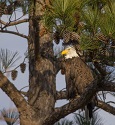 How much do you know about our nation’s national bird, the bald eagle? Take this quiz to find out. To watch a live eagle nest, visit the Pennsylvania “Nest Cam,” which covers a bald eagles’ nest near Hanover, PA, during the winter and spring breeding season. 1. Bald eagles are not bald. Their name comes from an old English word, “balde.” What does balde mean?
How much do you know about our nation’s national bird, the bald eagle? Take this quiz to find out. To watch a live eagle nest, visit the Pennsylvania “Nest Cam,” which covers a bald eagles’ nest near Hanover, PA, during the winter and spring breeding season. 1. Bald eagles are not bald. Their name comes from an old English word, “balde.” What does balde mean?
A. Feathered
B. Fish
C. Soaring
D. White
2. What do bald eagles eat?
A. Fish, snakes & turtles
B. Rabbits & muskrats
C. Dead animals
D. All of the above
3. The female bald eagle is larger than the male. How long is her wingspan?
A. 4 feet
B. 6 feet
C. 8 feet
D. 10 feet
4. Bald eagles can fly about 40 miles per hour. When diving for prey, though, they can reach a much higher speed. How fast are their dives?
A. 77 mph
B. 100 mph
C. 125 mph
D. 150 mph
5. About how many feathers does a bald eagle have?
A. 5,000 feathers
B. 6,500 feathers
C. 7,000 feathers.
D. 8,500 feathers
6. Eagles use their feathers to keep their balance. What happens if an eagle loses a feather on one of its wings?
A. It loses the matching feather on the other wing.
B. It grows a new feather within 2 weeks.
C. The two adjoining feathers will split to take the lost feather’s place.
D. The eagle has to learn how to fly again.
7. Bald eagles were in danger of becoming extinct in the mid-20th century, as a result of habitat destruction and degradation, illegal shooting, and eating prey contaminated with lead shot (waterfowl) and DDT (fish). How did DDT affect bald eagles?
A. It gave them bone cancer.
B. It caused them to lay eggs with thin eggshells.
C. It stunted their feathers.
D. It caused blood poisoning.
Answers:
1-D, 2-D, 3-C, 4-B, 5-C, 6-A, 7-B

